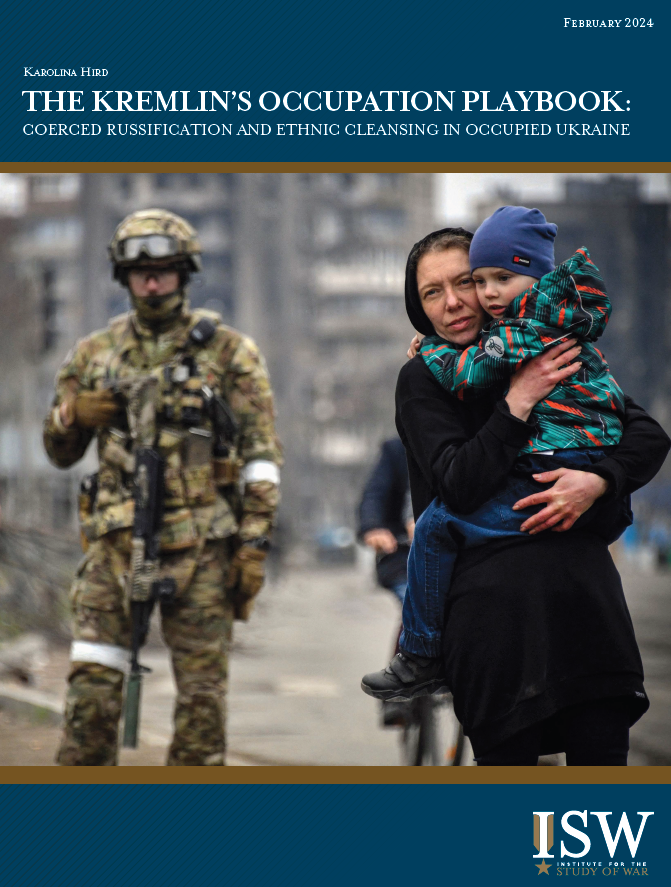 |
 |
The Kremlin's Occupation Playbook: Coerced Russification and Ethnic Cleansing in Occupied Ukraine

The Kremlin's Occupation Playbook: Coerced Russification and Ethnic Cleansing in Occupied Ukraine
February 9, 2024
Click here to download the full report.
The war in Ukraine is primarily a war for control of people, not land. Russian President Vladimir Putin has invaded Ukraine twice not mainly because he desires Ukraine’s land, but rather because he seeks to control its people. Putin’s project, explicitly articulated in the 2021 article he published justifying the 2022 full-scale invasion, is the destruction of Ukraine’s distinctive political, social, linguistic, and religious identity.[1] Putin seeks to make real his false ideological conviction that Ukrainians are simply confused Russians with an invented identity, language, and history that a small, Western-backed minority is seeking to impose on the majority of inhabitants. He sees language as one of the primary determinants of ethnicity—Russian speakers, he claims, must be Russians regardless of the state they live in.[2] The Russian Federation has claimed special rights to protect Russians in the former Soviet states since the 1990s, although the Kremlin did not act on those claims until Putin became president.[3] Putin’s aim to destroy Ukrainian identity, language, and culture is thus one of the primary objectives of his entire enterprise.
The stakes of this war thus transcend hectares of land. They include the lives, freedom, and identities of nearly five million Ukrainians currently living under Russian occupation, the nearly five million more whom the Kremlin has illegally deported to Russia and the additional millions who have fled their homeland to other parts of Ukraine or abroad.[4] Dry, abstract, “realist” discussions about pressuring Ukraine to make “concessions”—to “trade land for peace”—ignore the reality of the war. This war is about people as well as land, and Western leaders cannot dismiss the consequences of the policies they pursue and demand.
Russia first experimented with its occupation playbook in 2008 when it invaded Georgia and occupied the Georgian territories of the South Ossetia and Abkhazia “republics.”[5] Russia further developed means and methods of occupation in Ukraine after it invaded and seized Crimea and parts of Donbas in 2014. The international community denounced the 2014 invasion, refused to recognize Russia’s claims to these areas, and heavily sanctioned involved Russian actors.[6] The international response, however, failed to discourage Russia from continuing its occupation of Ukraine and setting conditions for the 2022 full-scale invasion. Russia succeeded in forcing the international community to accept and internalize the 2014 occupation enough that many even in the West now view the 2014 territories as different from the rest of Ukraine.
Russia is now applying these means and methods of occupation on an expanded scale in the Ukrainian territories it occupied since the full-scale invasion that began on February 24, 2022. The Kremlin’s occupation design aims to eliminate Ukrainian identity by forcibly integrating occupied Ukraine into Russia socially, culturally, linguistically, politically, economically, religiously, and bureaucratically. Moscow ultimately seeks to persuade Kyiv and its supporters that the forced integration of Ukraine into Russia, and the resulting elimination of Ukrainian identity, are permanent and irreversible so that the Kremlin can fully subjugate these territories and people for its own gain.
Putin also seeks to use Ukraine as a source of mobilizable manpower in part to address Russia's demographic issues. Russia has been struggling since the beginning of the 1990s with a demographic crisis, caused by declining birthrates, an aging population, low life expectancy (particularly amongst males of working age), and high levels of emigration.[7] The war has somewhat exacerbated Russia’s demographic challenges because 800,000- 900,000 Russians fled the country after the start of the war, including up to 700,000 who ran after Putin ordered partial mobilization in September 2022.[8] Russian Federal State Statistics Service (Rosstat) data shows that Russia’s labor shortage amounted to 4.8 million people in 2023, a problem that has reduced Russia’s economic output.[9] Rosstat also estimated in 2023 that Russia’s population will decline naturally at a rate of more than 600,000 people per year until 2032.[10]
Rosstat reported that the Russian population was 146 million as of January 1, 2023.[11] Five million Ukrainians living in Russian-occupied areas, plus the 4.8 million Ukrainians whom Russia has deported into the Russian Federation, thus comprise about 7 percent of the current Russian population. Russian efforts to control Ukrainian land and seize its people are therefore in part intended to offset Russia’s population decline and workforce shortages.
[1] http://kremlin dot ru/events/president/news/66181
[2] http://kremlin dot ru/events/president/news/66181; http://kremlin dot ru/events/president/news/67828; http://kremlin dot ru/events/president/news/72863; http://www.kremlin dot ru/acts/bank/48502; https://www.understandingwar.org/backgrounder/russian-offensive-campaign-assessment-november-28-2023
[3] https://rs.gov dot ru/en/activity/compatriots/
[4] https://www.rferl.org/a/ukrainians-escape-russian-occuption-border-crossing/32636052.html
[5] https://www.atlanticcouncil.org/blogs/ukrainealert/the-2008-russo-georgian-war-putins-green-light/
[6] https://www.radiosvoboda dot org/a/25293553.html; https://www.reuters.com/article/us-ukraine-crisis-nato-idUSBREA2D1NI20140314/; https://2009-2017.state.gov/secretary/remarks/2014/04/225166.htm
[7] https://www.rand.org/pubs/issue_papers/IP162.html; https://www.rferl.org/a/russia-demographic-data-dip-as-small-1990s-generation-comes-of-age/30373049.html; https://carnegieendowment.org/2012/01/26/russia-s-demographic-crisis-event-3537; https://www.understandingwar.org/backgrounder/russian-offensive-campaign-assessment-october-22-2023; https://www.understandingwar.org/backgrounder/russian-offensive-campaign-assessment-april-15-2023
[8] https://www.forbes.ru/society/478827-rossiu-posle-21-sentabra-pokinuli-okolo-700-000-grazdan; https://news.err.ee/1608738886/forbes-up-to-700-000-citizens-have-left-russia-since-mobilization-declared; https://www.reuters.com/world/europe/where-have-russians-been-fleeing-since-mobilisation-began-2022-10-06/; https://www.understandingwar.org/backgrounder/russian-offensive-campaign-assessment-october-28; https://www.economist.com/graphic-detail/2023/08/23/russians-have-emigrated-in-huge-numbers-since-the-war-in-ukraine; https://www.bbc.com/news/world-europe-65790759;
[9] https://www.understandingwar.org/backgrounder/russian-offensive-campaign-assessment-december-24-2023; https://iz dot ru/1624816/mariia-stroiteleva/kak-zhe-bez-ruk-defitcit-rabotnikov-v-2023-godu-sostavil-48-mln
[10] https://www.understandingwar.org/backgrounder/russian-offensive-campaign-assessment-october-22-2023
[11] https://www.kommersant dot ru/doc/5798564; https://www.moscowtimes dot io/2023/10/20/rosstat-prognoziruet-sokraschenie-chisla-rossiyan-pochti-na-8-mln-chelovek-k-46g-a110719
